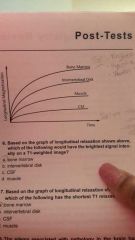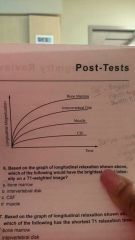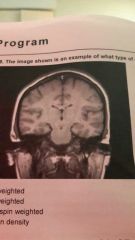![]()
![]()
![]()
Use LEFT and RIGHT arrow keys to navigate between flashcards;
Use UP and DOWN arrow keys to flip the card;
H to show hint;
A reads text to speech;
54 Cards in this Set
- Front
- Back
- 3rd side (hint)
|
An RF pulse of what flip angle will maximize the component of the net manetization projected into the transverse plane?
|
90 degrees
|
|
|
|
T1 relaxation refers to ___________ relaxation.
|
longitudinal
|
|
|
|
Which of the following statements are false?
a. T1 relaxation refers to the longitudinal recovery of manetization while T2 relaxation refers to the transverse decay of manetization. b. T1 relaxation and T2 relaxation occur simultaneously. c. echos collected in the transverse plane demonstrate only T2 relaxation differences. d. T2 relaxation occurs much more quickly than T1 relaxation. |
c. echos collected in the transverse plane demonstrate only T2 relaxation differences.
|
|
|
|
If the precessional frequency of the protons net magnetization is approximately 21 MHx a ___ Telsa magnetic field is being experienced by the patient's protons.
|
0.5
|
* Use the Larmor Equation
f=(y/2n)B f= resonant or Larmor frequency in MHz y/2n= Gyromagnetic ratio in MHz/T B= Magnetic field in Telsa |
|
|
Which of the following is the definition of T1 relaxation?
|
The time it takes the net longiudinal magneization of protons to grow to 63% of its final amplitude.
|
|
|

Based on the graph of longitudinal relaxation shown above, which of the following would have the brightes signal intensity on a T1 weighted image?
|
bone marrow
|
Short T1, bright, highest amplitude
|
|

Based on the graph of the longitudinal relaxation shown above, which of the following has the shortest T1 relaxation time?
|
Bone marrow
|
|
|
|
The edema associated with pathology in the brain has a much longer T2 relaxation time than surrounding normal brain tissue. On a T2-weighted image, what does this result in?
|
High signal intensity in the area of edema
|
|
|
|
After a 90 degree RF pulse, if three 180 degree pulses are applied to generate three echoes, which of the following is responsible for the third echo being smaller than the first echo?
|
spin spin interactions
|
|
|
|
Which of the following dephasing mechanisms affect the size of the resulting spin echo?
|
spin spin interactions
|
|
|
|
The MR echo is NOT:
|
Collected only one time for given image.
|
|
|
|
What is the time from the initial RF excitation pulse to the echo called?
|
TE (Echo TIME)
|
|
|
|
The proton's _____________ contributes to its magnetic properties.
|
Spinning motion and positive charge
|
|
|
|
Which of the following is TRUE regarding the hydrogen protons in a patient's body when placed in the magnet of an MR system?
|
More protons align with the main magnetic field than against the main magnetic field.
|
|
|
|
On a T2 weighted image, CSF appears bright because it has a ___________ relaxation time.
|
Long T2
|
|
|
|
The precessional frequency of the net magnetization of protons in a magnetic field is determined by which of the following?
|
the gyromagnetic ratio and the field strength
|
|
|
|
The RF pulse should be transmitted at a frequency of approximately _____ MHz in order to disturb protons experiencing a 4 telsa field.
|
170
|
* 1 Telsa = 42.6
|
|
|
Referring to the figure below, if the main magnetic field is aligned along the z-axis which of the following corresponds to the correct orientation of the transverse plane?
|
x-y
|
|
|
|
Which of the following is NOT a requirement for magnetic resonance imaging?
|
ionizing radiation
|
|
|

Referring to the image below, if the main magnetic field is aligned along the y axis , which of the following corresponds to the correct orientation of the transverse plane?
|
x-z
|
|
|
|
What is the phenomenon called in which one proton transfers energy to another?
|
a spin spin interaction
|
|
|
|
Which of the following parameters controls the amount of contrast seen in an image due to T2 relaxation?
|
TE (echo time)
|
|
|
|
What is the time from the initial RF excitation pulse to the next RF excitation pulse for a given slice called?
|
TR *initial pulse
***TE *initial echo |
|
|
|
From a resting state in which the fully relaxed net magnetization is aligned along the longitudinal direction, what would the application of a single 45 degree RF pulse result in?
|
Equal amounts of transverse and longitudinal magnetization
|
|
|
|
Which of the following is the definition of T2 relaxation time?
|
The time at which the transverse magnetization has decayed to 37% of its full value.
|
|
|
|
By increasing the TE from 80ms to 120ms on a spin-echo pulse sequence, which of the following is the expected result?
|
Better tissue contrast based on the tissues T2 characteristics.
|
Longer TE = higher contast
|
|
|
By decreasing the TR from 1000ms to 500ms on a spin echo pulse sequence, which of the following is the expected result?
|
Better tissue contrast based on the tissues T1 characteristics
|
Short T1= higher contrast
|
|
|
If six successive 180 degree RF pulses are applied, following a 90 degree RF pulse, how many echos will be formed?
|
Six
|
|
|
|
If six sucessive 180 degree RF pulses are applied, following a 90 degree RF pulse, echo ______ will contain the GREATEST signal?
|
One
|
|
|
|
After dephasing that results following a 90 degree RF pulse, which of the following RF flip angles maximizes the component of the net magnetization in the transverse plane at the time of the spin echo?
|
180 degree
|
|
|
|
Using a spin echo pulse sequence which generates two echoes, imaging a hypothetical tissue in whch the protons never experience spin-spin interactions. How does thhe signal from the first echo compare to the signal from the second echo?
|
It is the same size
|
|
|
|
What is the time from the 180 degree RF pulse to the echo?
|
0.5 x TE
*The 180 degree pulse is placed exactly half way between the time of the 90 degree pulse and the desired echo time. |
|
|
|
The time from the 90 degree pulse to the echo is the:
|
TE
|
|
|
|
The time from the 90 degree pulse to the next 90 degree pulse is:
|
TR
|
|
|
|
Which of the following dephasing mechanisms is NOT rephased by a 180 degree RF pulse?
|
Spin spin interactions
*The 180 degree RF pulse rephases the signal losses caused by a number of dephasing mechanisms because it creates an equal but opposite effect on the spin behavior of protons. The 180 degree pulse cannot recover signal losses due to the dephasing mechanism that forms the basis of T2 weighted imaging. |
|
|
|
Which of the following parameters controls the amount of contrast seen in an image due to T2 relaxation?
|
TE
|
|
|
|
The effect of an IV administered paramagnetic contrast agent used in MRI is a shortening of the T1 relaxation time of the protons within any perfused tissue. A vascular lesion would appear ________________ on a T1 weighted contrast enhanced image as compared to its appearance on a T1 weighted unenhanced image.
|
Brighter
*The introduction of a contrast agent which further shortens the T1 time of blood will make perfused tissues appear like shorter T1 tissues. Short T1 has higher contrast between tissues. |
|
|
|
In a given MR system, the magnetization of protons within a patient precesses at 63.83 MHz. Without the interference of any other system component, what is the expected result if RF energy is applied at a frequency of 63.83 MHz?
|
All of fthe patient's protons within the range of the transmitting antenna will be disturbed by the external energy.
|
Since their are no other interference of any other system components... their are NO gradient pulses applied. The only source of energy is the MR system.
|
|
|
If the field strength experienced by a patient within an MR magnet is increased, the precessional frequency of the magnetization of the patient's protons will:
|
Increase
|
|
|
|
The energy used to form MR images is _______________ the patient's tissues.
|
Released from
|
|
|

The image shown is an example of what type of contrast?
|
T1
*These conditions are created by using a short TR which prevents the longitudinal magnetization to recover in tissues with long T1 times. |
T1 fluid is dark
Tissues are intermediate shade of gray Fat is bright |
|
|
As an MR technologist, which of the following occurs as you walk toward the MR magnet to position a patient?
|
1. The net magnetization within your body increases
2. The precessional frequency of the protons magnetization within your body increases. |
|
|
|
T1 relaxation is also called:
|
Spin lattice relaxation
*This is because the energy which is released by the protons is received by the surrounding molecular lattice. |
|
|
|
T2 relaxation is also called:
|
Spin spin relaxation
*This is because the energy is released by a proton (or spin) as it interacts with another proton causing it ot lose some of its phase in the transverse plane. |
|
|
|
In the vast majority of tissues T2 time is shorter than the T1 time. T/F?
|
True
|
|
|
|
In a T1 weighted image the signal contributed by the tissue with the shortest T1 generally will be stronger than that contributed by the other tissue an will appear __________ on the reconstructed image..
|
Brighter
|
*Bone marrow is fat based.
|
|
|
The tissues which demonstrates the most rapid recovery of the longitudinal magnetization has the _________ T1 relaxation time.
|
Shortest
|
|
|
|
Substances with a long T2 relaxation time exhibit a lower rate of spin-spin interactions, and this results in a slower loss of transverse magnetization. The consequence of this is that the strength of the echo in the transverse plane persists at _______ TE times in substances which have _____ T2 relaxation times.
|
Long
|
|
|
|
The loss of signal due to the spin spin interaction cannot be prevented since the spin spin interaction is an inherent irreversable process which can be experienced by every proton. T/F?
|
True
*In other words, the 180 degree RF pulse cannot revert the loss of signal caused by spin spin interactions. |
|
|
|
Magnetic suseptibility, phase effect of chemical shift, and field inhomogenities are present in gradient echo images but not is spin echo images because gradient echo pulse sequences do not enjoy the rephasing effects of:
|
The 180 degree RF pulse.
|
|
|
|
The number of echoes collected is equal to:
|
The size of the acquisition matrix along the phase encoding direction.
|
|
|
|
TI is:
|
The time between the initial 180 degree RF pulse and the 90 degree excitation pulse in an INVERSION RECOVERY sequence.
|
|
|
|
TE is:
|
The time between the RF excitiation pulse and the center of the echo.
|
|
|
|
TR is:
|
The time between successive RF excitation pulses.
|
|

